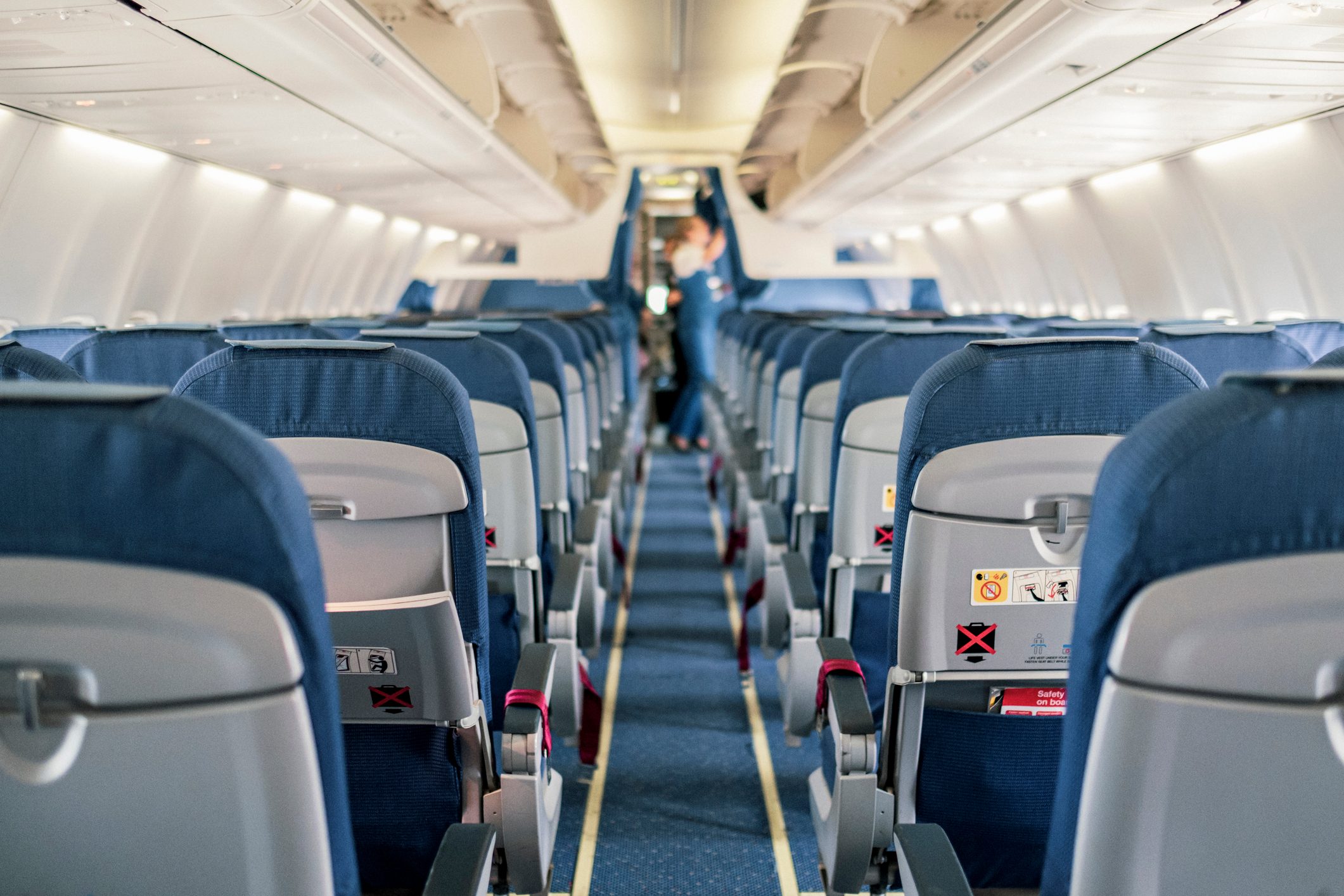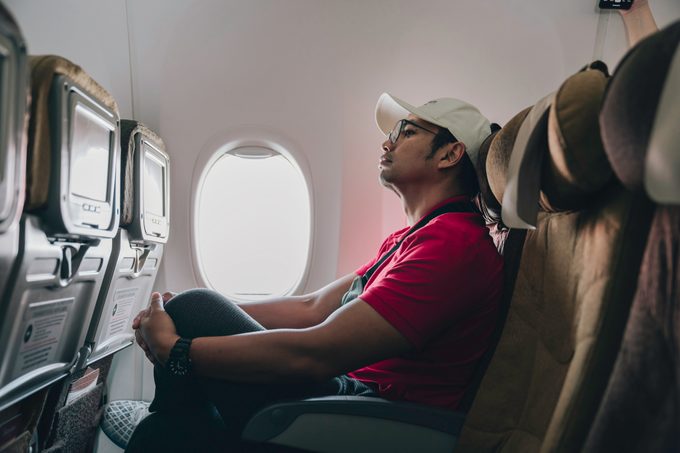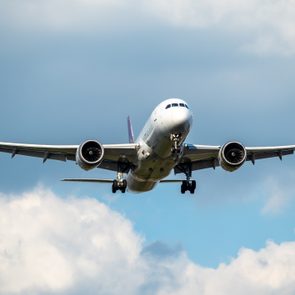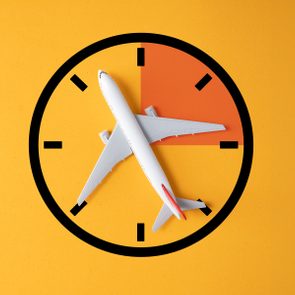Learn the two golden rules of choosing a seat to avoid getting sick

Flying During Flu Season? This Is the Least Germy Place to Sit on a Plane

Traveling in winter can feel less like you’re flying the friendly skies and more like you’re enduring the phlegmy skies. You hear a passenger hacking up a lung behind you, and you just want to deplane without catching the plague. So where should you sit on a plane to lower your risk of catching the flu, COVID-19 or a bad cold?
As someone who reports on travel and public health, I wondered what seat is best for staying healthy. To find out, I turned to infectious-disease experts, including Bernadette Boden-Albala, MPH, DrPH, founding dean of the Joe C. Wen School of Population and Public Health at the University of California, Irvine. She started by sharing good news: “Modern airplanes have high-efficiency particulate air filters that clean recirculated air, so airborne particles like viruses are significantly reduced.”
Don’t breathe a sigh of relief just yet. “The problem is really with your fellow travelers,” she warns. If you come into direct contact with an airplane passenger who has the flu or another bug, you could very well catch it. (A virus is going to virus.) But interestingly, your plane seat really can affect your odds of staying healthy.
Read on to find out where to sit (and not sit), whether you should move around and what else you can do to ward off the flu and other viruses.
Get Reader’s Digest’s Read Up newsletter for more travel, tech, cleaning, humor and fun facts all week long.
So what’s the best seat on a plane for avoiding germs?

Surprise: It’s the window seat. “In most cases, the ideal place to sit on a plane in terms of reducing the risk of flu and colds is a window seat because it’s farther away from high-traffic areas like the aisle and bathroom,” Boden-Albala says.
In fact, a study published in Proceedings of the National Academy of Sciences looked into how respiratory illness might spread during transcontinental flights and found there is less risk if you sit near a window and then just stay put. Moving around the cabin is not a good idea. It increases your odds of being within 3 to 6 feet of unwell travelers and touching germy surfaces.
But while you’re kicking back in your window seat, don’t rest your head against the window. It’s a super germy spot that has been shown to harbor Staphylococcus aureus bacteria.
If my rowmate is coughing, should I ask to move seats?
It’s tempting to want to get away from Typhoid Mary, but it might not help much. “Someone could be a few rows back coughing or sneezing, and the droplets from that can travel quite a distance,” says Karen Duus, PhD, professor of microbiology and immunology at Touro University in Nevada.
She points to a 2016 systematic literature review of 14 studies revealing that 42% of people exposed to influenza on a plane who became ill were seated within two rows of the index case. “So that means 58% were farther away,” she says. Her advice? “Wear a mask, which can protect you from those droplets and particles floating in the air.”
Are you better off in the front, middle or back of the plane?
Alas, there’s no such thing as a no-flu zone. It doesn’t matter what region you pick, though you should avoid seats by the plane’s bathroom. “Sitting in a seat close to the bathroom, where people line up, would only increase your exposure to potential viruses,” Boden-Albala says.
When you book your seats online, check the blueprint of the plane and go with a row far from a restroom.
Is first class a disease-prevention upgrade?
Luxe seats come with elbow room—and breathing room. “You need a minimum of 3 feet between people in order to reduce the risk of droplet infection, so in that sense, the extra space may help,” notes microbiologist Jason Tetro (aka the Germ Guy), host of The Super Awesome Science Show podcast.
But in general, first class doesn’t come with a guarantee you won’t get coughed on. “Go for the comfort, not the infection prevention,” he says.
What else can you do to stay healthy when flying?
Beyond carefully picking your seat, there are other tricks to minimizing the risk of getting sick from air travel. Here are few insider tips to keep in mind, especially during cold and flu season.
Wipe down the tray table
“Hard surfaces like tray tables, seat belts and seat arms are more likely to transmit intact viral particles,” Duus says. “Influenza viruses can survive for several hours on surfaces, and many common cold viruses can survive much longer.” Use a sanitizing wipe to remove viruses and bacteria.
Don’t touch that flusher
The flush button and other surfaces in the loo are some of the ickiest spots on the plane. “Don’t touch bathroom fixtures directly after washing your hands,” Duus advises. “Use a paper towel to turn off faucets and open doors.”
Use your nozzle
There’s no good research looking into whether opening your air vent helps or hurts with virus prevention, Duus says. Yet she believes in opening the valve and positioning it down in front of her.
The trick isn’t about air quality (it’s a myth that you’re breathing in only recirculated air on flights); it’s about airflow. “The downward airflow from the air vent could help direct particles away from you, reducing the likelihood of inhaling them,” she explains.
Drink up
Staying hydrated is a simple way to keep your immune system going strong. Yet dry air in the cabin makes it easy to accidentally get dehydrated. To counteract that, sip bottled water throughout your flight. Whatever you do, skip the hot tea and coffee; these drinks are made with tap water, and who knows how often the aircraft’s water tanks are cleaned.
Steer clear of the pocket
On Reddit, candid flight attendants have spilled that airplane seats’ back pouches are germ hot spots, mainly because they’re tidied but not properly sanitized. The icky items they’ve found in that black hole include dirty tissues and poopy diapers. Egad.
Mask up
Wear an N95 or a KN95 mask—or just stash one in case of emergency, which is what Boden-Albala does. “I always pack a mask with me for situations where I might find myself sitting next to someone who is sick,” she says.
Tetro adds that masking up delivers double protection. “Masks not only help block some particles from being inhaled but also prevent you from unconsciously touching your nose and mouth and transmitting something from touch,” he says.
Be kiosk cautious
Cold and flu prevention starts before you even step foot on the plane. Yes, we’re talking about the airport terminal. One study investigated the germiest places in the airport and found that the self-check-in kiosks are loaded with bacteria and fungal cells. The next worst spot? The armrests at the gate benches. Keep a small bottle of hand sanitizer in your carry-on, and be sure to use it after touching any shared surface.
Roll up your sleeve
The best way to protect yourself from winter bugs is to stay up to date with your flu shot and COVID-19 booster. But you know that already, right?
About the experts
|
Why trust us
At Reader’s Digest, we’re committed to producing high-quality content by writers with expertise and experience in their field in consultation with relevant, qualified experts. We rely on reputable primary sources, including government and professional organizations and academic institutions as well as our writers’ personal experience where appropriate. We verify all facts and data, back them with credible sourcing and revisit them over time to ensure they remain accurate and up to date. For this piece, Lisa Lombardi tapped her experience as a longtime health reporter and the author of What the Yuck?! The Freaky and Fabulous Truth About Your Body to ensure that all information is accurate and offers the best possible advice to readers. Read more about our team, our contributors and our editorial policies.
Sources:
- Bernadette Boden-Albala, MPH, DrPH, founding dean of the UC Irvine Joe C. Wen School of Population & Public Health; email interview, Dec. 16, 2024
- Karen M. Duus, PhD, professor of microbiology and immunology at Touro University Nevada; email interview, Dec. 17, 2024
- Jason Tetro, microbiologist, author of The Germ Code and The Germ Files, and host of the Super Awesome Science Show podcast; email interview, Dec. 17, 2024
- PNAS: “Behaviors, movements, and transmission of droplet-mediated respiratory diseases during transcontinental airline flights”
- Epidemiology: “Review Article: Influenza Transmission on Aircraft: A Systematic Literature Review”























